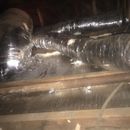Blowing Cellulose Insulation into an Old Attic with Flex Ducts
Hello! I have a home in northern NJ built in 1895. It has a pitched flat vented roof. The roof is made up of torched down bitumen material. The attic is accessible from the front of the house and pitched to the back. I wanted to insulate the attic (currently uninsulated!) with blown in cellulose. The floor of the attic is the ceiling of the second floor that has plaster and lath. I have two issues that I am wrestling with. One is that there is a furnace in the attic with several flexible ducts that run throughout the front and the back of the attic. The ducts are only used for heating and no cooling. I have no plans for adding a cooling system (maybe a Fujistsu minisplit on the second floor later). Will it be okay to blow cellulose around and underneath the ducts but not totally embed them in the cellulose? I have read several articles that recommend to totally embed them but I don’t think it’s possible to totally embed all the ducts. The other issue is will the 125 years of floor beams hold up the weight of the cellulose. Currently the beams are not sagging.
First attached picture is of the floor and ceiling of the front of the attic. Second picture is of the big return duct and smaller supply ducts. The floor here foil bubble sheet material. Thank you for your input!
GBA Detail Library
A collection of one thousand construction details organized by climate and house part











Replies
Is the reason you don't think you can completely cover them a cost issue (more insulation)?
No, it’s not a cost issue. I have lot of money!
It’s because the attic is pitched and I won’t be able to access the all the sides of the ducts in the inaccessible area of the attic.
I know you need to completely cover the ducts when there is cooling involved. But these are flexible insulated ducts and only provide heat.
Michael,
While you are waiting for more input, be sure to read this article: https://www.greenbuildingadvisor.com/article/burying-ducts-in-attic-insulation.
Thanks Steve. I read the article. Martin says that
"The concerns about condensation addressed in this article arise with ducts connected to an air conditioner. These issues do not arise with ducts connected to an HRV, because ducts connected to an HRV never get cold enough to raise condensation concerns."
I don't know if it still applies to me since I only have heat and no AC.
The reason to not put ducts in an unconditioned space is that the conditioned air in the ducts is impacted by the temp of the unconditioned air outside the ducts. When there is enough of a temp and dew point differential you also get condensation.
People with more knowledge than me can post on whether there is a reverse condensation concern.
The questions I would be asking are:
1. Weight - which you have asked. I would be very concerned about how much weight your plaster & lathe ceiling can hold. I am also opposed to fiberglass, so understand cellulose, but this may be a good application for fiberglass.
2. You seem to have the foil faced bubble wrap installed between your ceiling joists. When the horizontal surface is kept clean it can radiate heat back up into the attic to reduce the amount of heat that goes into the the living space. But if you cover it with blown in it won't really work any more. May want to remove it, turn it around and tack it to the underside of the rafters (read other articles on here on why to turn it around).
Before any of this, I would work on air sealing. And if you are considering minisplits for cooling, remember they can also provide heat, so you could in theory reduce the use of or eliminate the need for these ducts. Or you could encapsulate the attic...
Thank you CL for your input. You think condensation would happen in my case of only heat? What is the reverse condensation? Is that when condensation forms on the inside of duct because of attic cold air and hot duct air?
1. I would think the wooden path strips would be strong for cellulose. Currently, I don’t see any bowing.
2. The foil faced bubble wrap is same on both sides. It’s only in one small part of the attic.